iPhone 11 vs. iPhone 11 Pro vs. iPhone 11 Pro Max: Which should you buy?

The three iPhone 11 models that first arrived in 2019 certainly don't have the buzz they used to — not with four iPhone 12 models replacing them at the top of Apple's smartphone lineup. But you still can get your hands on any one of these phones if you want. In fact, the iPhone 11 is still part of Apple's phone lineup, and at a reduced price, too.
As a result, it pays to know the iPhone 11 vs iPhone 11 Pro vs iPhone 11 Pro differences, so can help you decide which model is the right choice for you.
- Find the best iPhone 11 deals
- iOS 14 review: What's new with the iPhone's software
- Samsung Galaxy S20 Plus vs. iPhone 11 Pro: How Apple's phone compares
We've extensively tested each iPhone 11 model so that we can outline the similarities and differences. We've also continued to re-examine these phones since their September 2019 release, with an eye toward ranking the best iPhones.
If you're trying to determine whether the iPhone 11 remains a good buy or how that model compared to the iPhone 11 Pro and iPhone 11 Pro Max that came out at the same time, we can help. Here's a closer look at the iPhone 11 vs iPhone 11 Pro vs iPhone 11 Pro Max so that you can see how all three iPhones measure up. (Check out our iPhone 12 vs iPhone 11 and iPhone 11 vs. iPhone XR comparisons for a look at how Apple's phones have changed from year to year.)
iPhone 11 vs. iPhone 11 Pro vs. iPhone 11 Pro Max: The specs
| Model | iPhone 11 | iPhone 11 Pro | iPhone 11 Pro Max |
| Screen Size (Resolution) | 6.1-inch Liquid Retina HD (1792 x 828) | 5.8-inch Super Retina XDR (2436 x 1125) | 6.5-inch Super Retina XDR (2688 x 1242) |
| CPU | A13 Bionic | A13 Bionic | A13 Bionic |
| RAM | Unknown | Unknown | Unknown |
| Storage | 64GB, 256GB, 512GB | 64GB, 256GB, 512GB | 64GB, 256GB, 512GB |
| microSD? | No | No | No |
| Rear Cameras | 12-MP wide (f/1.8), 12-MP ultra wide (f/2.4) | 12-MP wide (f/1.8), 12-MP ultra wide (f/2.4), 12-MP telephoto (f/2.0) | 12-MP wide (f/1.8), 12-MP ultra wide (f/2.4), 12-MP telephoto (f/2.0) |
| Front Camera | 12-MP (f/2.2) | 12-MP (f/2.2) | 12-MP (f/2.2) |
| Battery Life (Hrs:Mins) | 11:16 | 10:24 | 11:54 |
| Water Resistance Rating | IP68 (2 meters up to 30 minutes) | IP68 (4 meters up to 30 minutes) | IP68 (4 meters up to 30 minutes) |
| Size | 5.9 x 3 x 0.33 inches | 5.7 x 2.8 x 0.32 inches | 6.2 x 3.1 x 0.32 inches |
| Weight | 6.84 ounces | 6.63 ounces | 7.97 ounces |
| Colors | Black, Green, Yellow, Purple, White, Product RED | Gold, Space Gray, Silver, Midnight Green | Gold, Space Gray, Silver, Midnight Green |
iPhone 11 vs. iPhone 11 Pros: Prices compared
Back in 2018, the iPhone XR introduced a price gap between Apple's entry-level smartphone and its more feature-rich models, and that gap only widened with the iPhone 11 family's debut. When the iPhone 11 arrived on the scene more than a year ago priced at $699, it was $300 cheaper than the iPhone 11 Pro.
The $999 iPhone 11 Pro and $1,099 iPhone 11 Pro Max, have since made way for the iPhone 12 Pro and iPhone 12 Pro Max, which cost the same as their predecessors. The iPhone 11 has stuck around, but at a lower price — you can have it for $599. (The iPhone 12 mini inherits the iPhone 11's $699 starting price, while the iPhone 12 costs $799.)
To encourage existing iPhone users to upgrade to new phones, Apple offers rebates if you trade-in your current phone. As of the end of April, you could knock up to $180 off the cost of an iPhone 11 by trading in an older iPhone. As for trade-in value for these older iPhone 11 models, they'll fetch the largest return. Buy an iPhone 12, for example, and you can save $515 by trading in an iPhone 11 Pro Max; an iPhone 11 will save you up to $465.
Get instant access to breaking news, the hottest reviews, great deals and helpful tips.
The iPhone 12 may be the new phone in town, but you'll still find all three iPhone 11 models available at the major carriers. (Apple has also added the iPhone 11 Pro models to the refurbished section of its online store.) Should you be interested in an iPhone 11, make sure that it's at a significant discount from its original price. For example, AT&T currently has a 256GB iPhone 11 Pro available for $17.50 a month over 30 months — a substantial discount from that phone's regular $1,049 asking price. (This particular deal requires a new line or an upgrade of an existing line.)
iPhone 11 vs. iPhone 11 Pros: Design and size
You definitely won't confuse the iPhone 11 with its Pro counterparts. The iPhone 11 features an aluminum and glass body and comes in a rainbow of colors — purple and green joined the black, yellow, white and red variants that are held over from the iPhone XR (which is still on sale at Apple for a reduced $499 price.) Purple has proven so popular it recently returned to the iPhone 12. (See our purple iPhone 12 hands-on.)
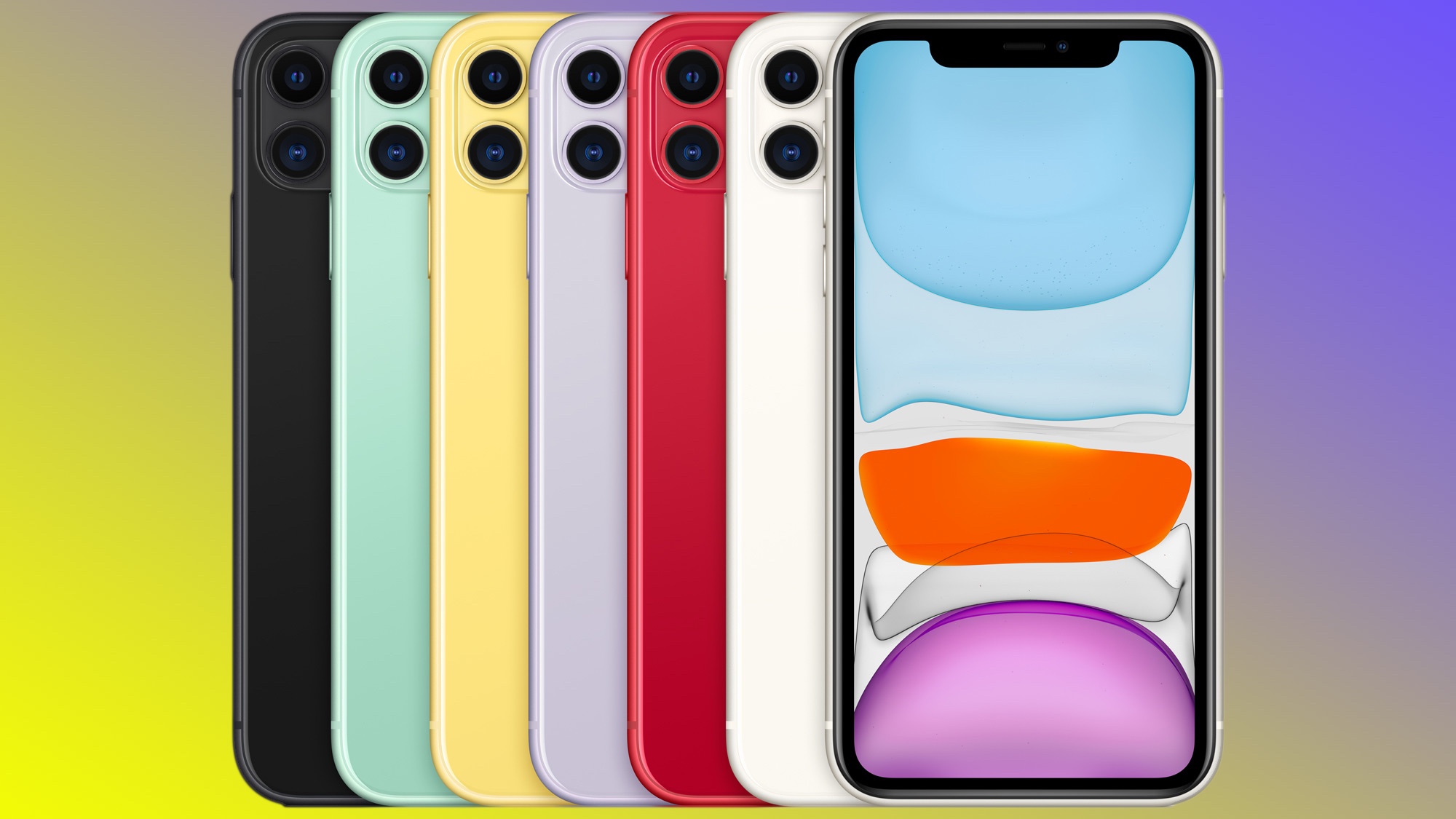
The iPhone 11 Pro and iPhone 11 Pro Max opt for a more sophisticated look. These phones use stainless steel for their frame, and the glass has a matte finish to it. Your color options are more staid here, though Apple does include a Midnight Green version alongside more traditional choices like Space Gray, Silver and Gold.
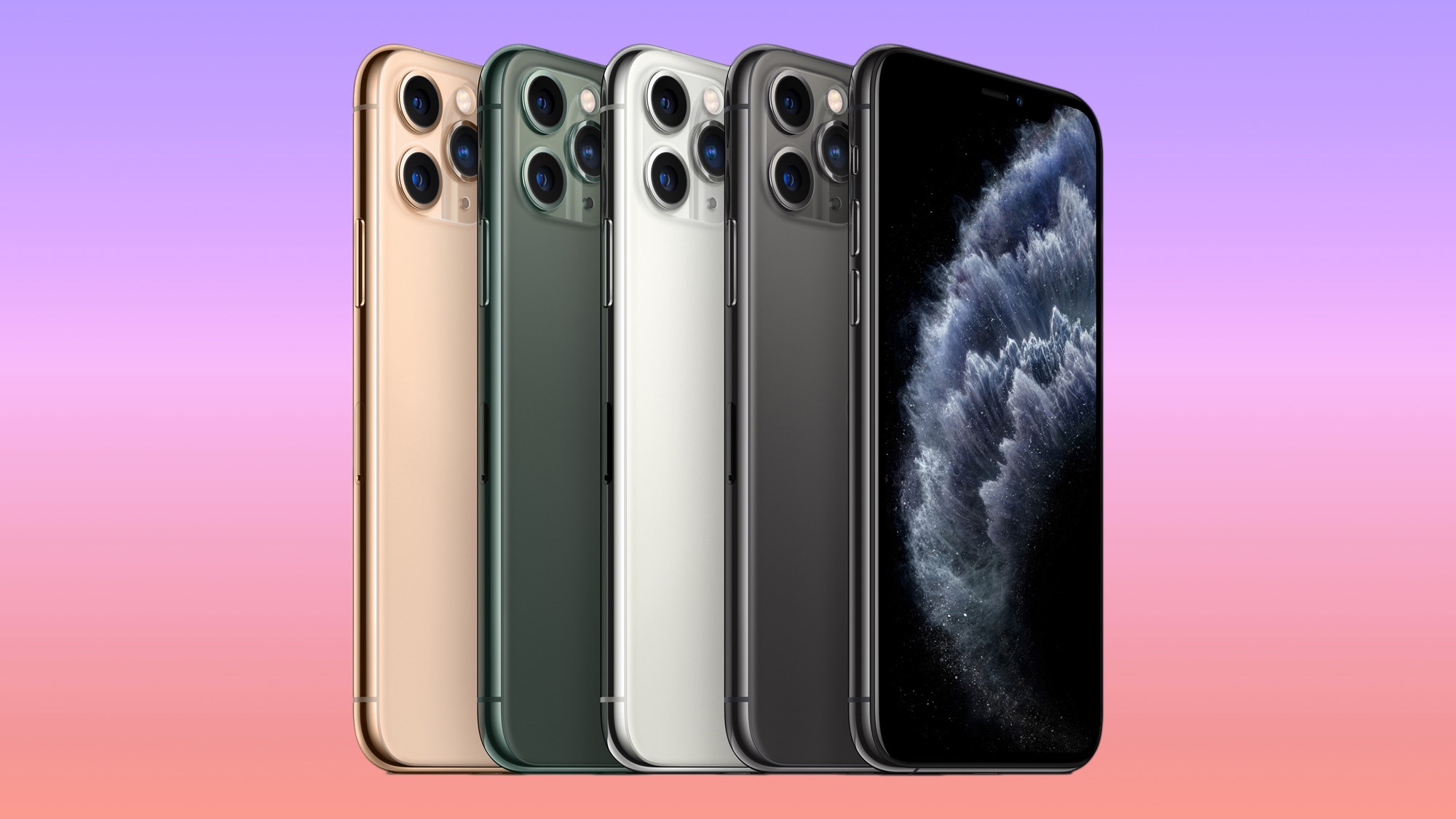
Apple emphasized the durability of the iPhone 11 Pro and 11 Pro Max when it introduced those phones in 2019. All three new iPhones boast IP68 dust- and water-resistance ratings, though not all IP68 ratings are apparently created equal. The iPhone 11 can survive a 30-minute dunk in up to 2 meters of water, while the Pro models can go a bit deeper to 4 meters. (These days, the iPhone 12 models can go 6 meters.)
No matter which model you pick up, you're going to get a noticeable camera bump. It's precision milled to fit in with the rest of the phone, whether you've got an iPhone 11 or one of the Pro models in your hand.
The same dimensions you saw with the iPhone XS, XS Max and XR are back with the current models. The iPhone 11 Pro Max is the tallest and widest of these three phones, and it weighs the most. (It's since been dwarfed by the iPhone 12 Pro Max and that phone's massive 6.7-inch display.) The next tallest phone, the iPhone 11 is also the thickest, though only by a fraction of an inch. The iPhone 11 Pro is the most compact model, though the iPhone 12 mini shrinks things further. As with recent iPhones, there's no headphone jack to be found on any of member of the iPhone 11 family.
iPhone 11 vs. iPhone 11 Pros: Displays
It's once again a tale of two displays for Apple's different smartphones. Like the iPhone XR before it, the iPhone 11 makes do with an LCD panel, while the iPhone 11 Pro and 11 Pro Max feature an OLED screen. (With the iPhone 12, all models switched to OLED.)
While little seems to have changed on paper about the iPhone 11's 6.1-inch Liquid Retina, it turns out to be brighter than the one on the iPhone XR (652 nits vs. 589 nits). The iPhone 11 registered 113% of the sRGB color gamut, which is nothing close to what you get with an OLED panel, though the iPhone 11's colors are very accurate. (That Delta-E rating of 0.22 is pretty close to a perfect score of zero on that test.)
When you look at the Super Retina XDR display that graces the iPhone 11 Pro and 11 Pro Max, though, you'll get a sense of why these models cost more. Both phones are super bright — the iPhone 11 Pro hit 752 nits on our light meter, while the 11 Pro Max topped 761. These are the phones you're going to want to take outside.
The colors on the Super Retina XDR display aren't as vibrant as what you'll get from some OLED panels, though that's a deliberate choice Apple makes in tuning its displays to be less saturated. The colors are accurate, though, with the iPhone 11 Pro Max recording a Delta-E score of 0.28.
One thing we've noticed with all three phones now that we've tested them — the spatial audio feature really makes a difference when you're watching videos. The wider sound stage, along with Dolby Atmos support, puts audio all around you, creating a more immersive experience.
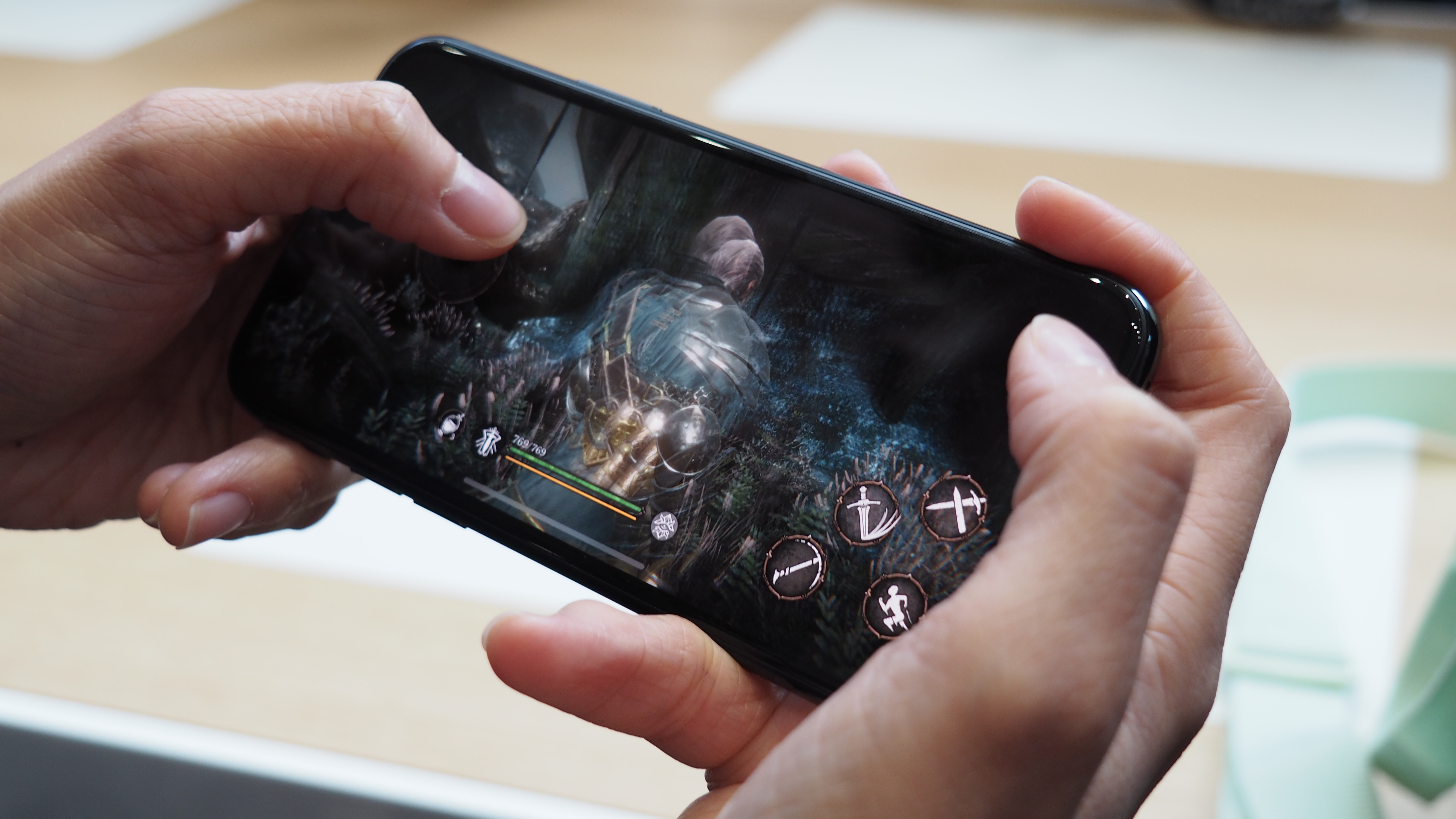
The iPhone 11 models feature the same screen sizes we saw on the 2018 phones. The iPhone 11 uses a 6.1-inch panel, which is smack dab in the middle of the iPhone 11 Pro's 5.8-inch display and the 6.5-inch screen on the iPhone 11 Pro Max. Like the Liquid Retina display on the iPhone 11, the Pro series screens feature Haptic Touch, instead of 3D Touch.
iPhone 11 vs. iPhone 11 Pros: Cameras
This probably stands out as the big differentiator between the iPhone 11 models. The iPhone 11 features two rear cameras — a 12-megapixel wide angle lens with an f/1.8 aperture and a 12-MP ultra wide lens with an f/2.4 aperture. That ultra wide lens delivers a 120-degree field of view so that you can capture more of your surroundings in images when you zoom out.
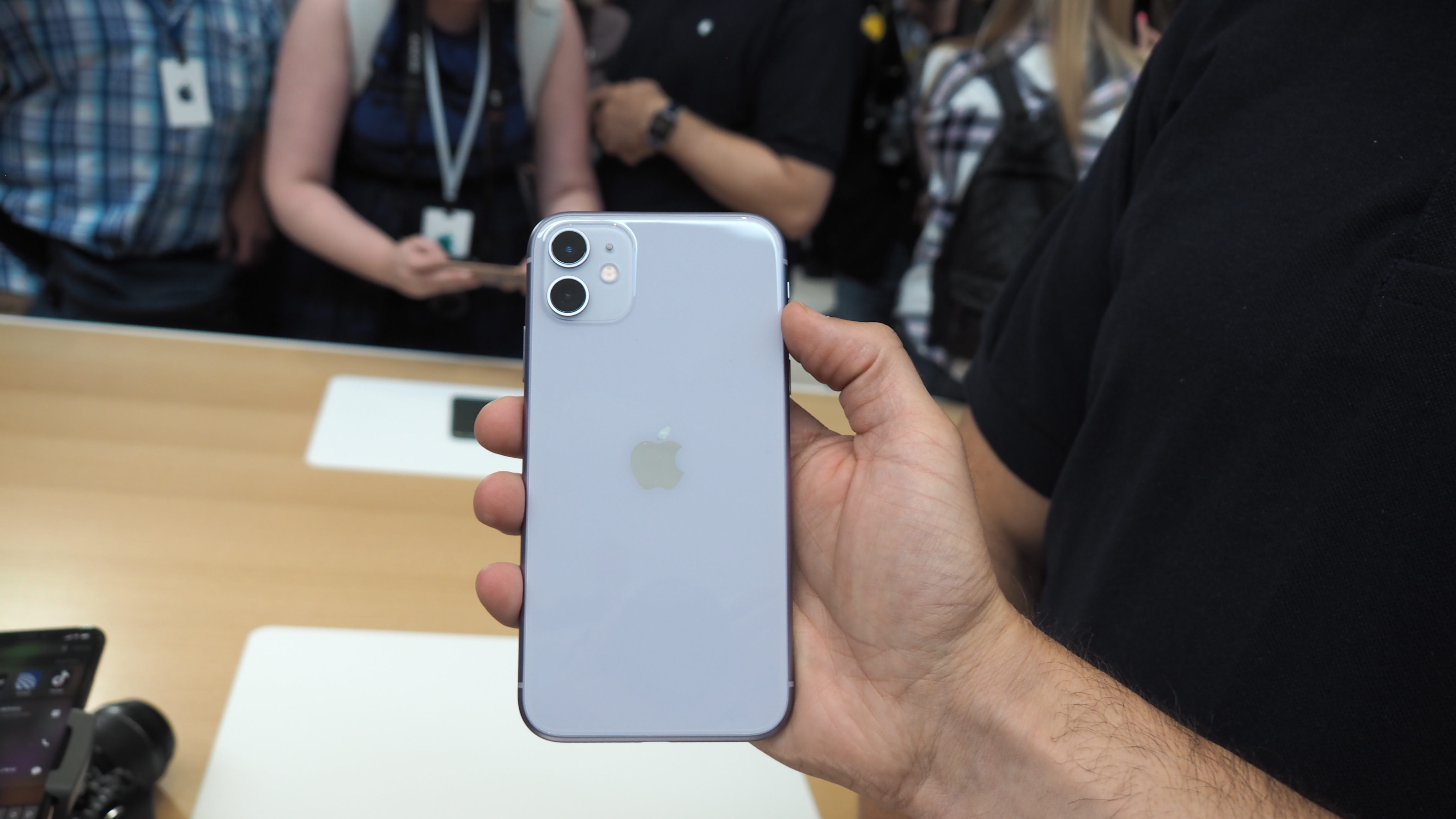
Those two cameras return on the iPhone 11 Pro and 11 Pro Max, but they're joined by a third 12-MP lens. This telephoto lens features an f/2.0 aperture, letting in 40% more light than the telephoto lens Apple included on the iPhone XS. You get a 2x optical zoom from the telephoto lens.
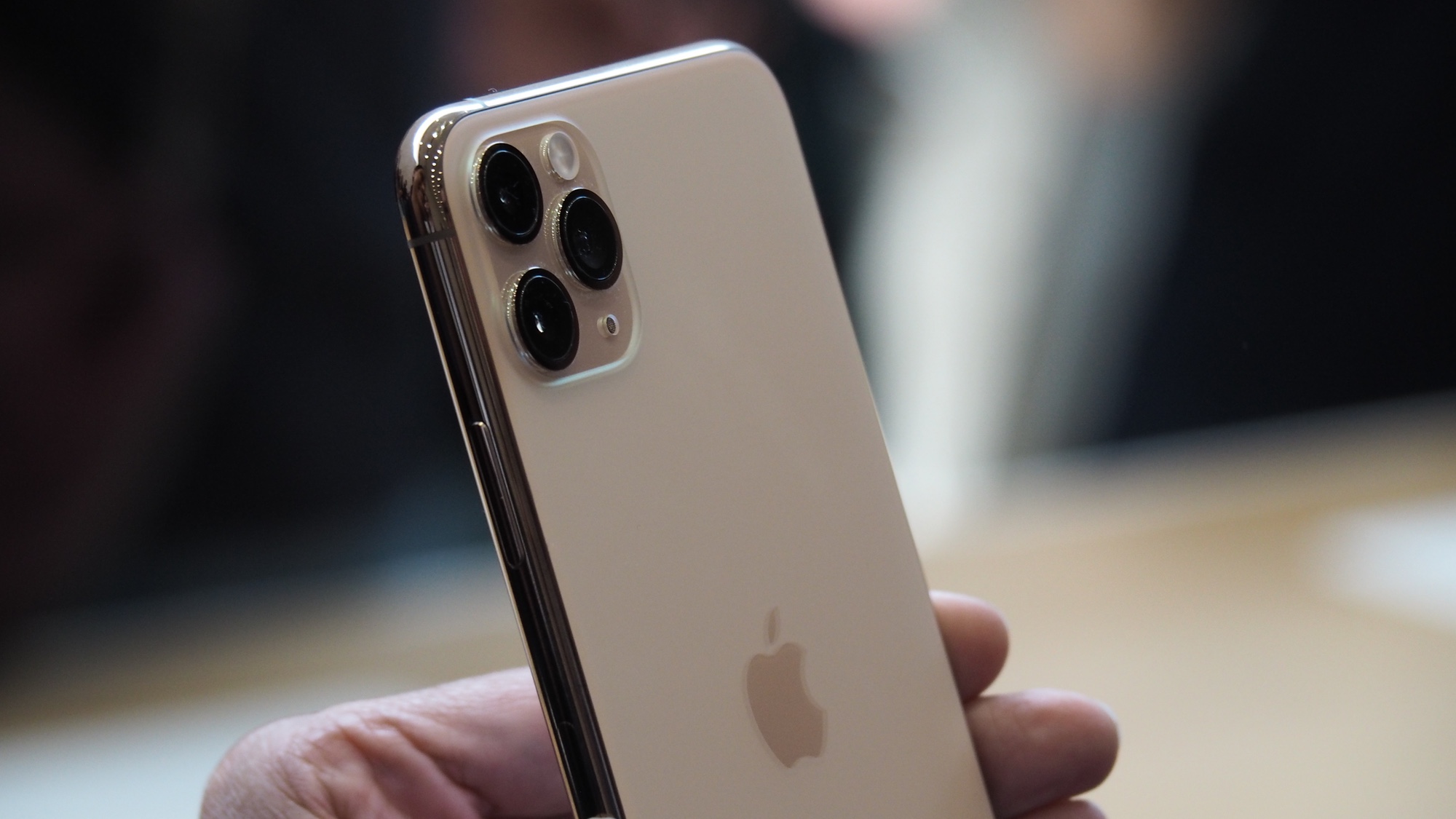
Despite the extra lens on the Pro models, the three phones support many of the same camera features. Whether you have an iPhone 11 or one of the Pro models, a Night Mode feature should mean better pictures in low light. All three new phones offer QuickTake, a new camera function where you can capture video while also shooting still images just by long-pressing on the shutter. Even the Deep Fusion feature, which combines nine different shots for a more detailed image, works on the iPhone 11 just as it does on the iPhone 11 Pro.
All three phones also sport the same 12-MP front camera and offer the ability to take slow-motion videos — a feature that Apple dubbed "slofies" to the rest of the world's apparent amusement. Those front cameras can also shoot 4K video at 60 fps, too.
All three iPhones fared impressively in our testing, which included comparing their output to images shot by leading camera phones from Google and Samsung. (We've got a full comparison between the iPhone 11 Pro and Pixel 4, its primary camera competition for best camera phone at the time.) The Night Mode feature is particularly welcome, letting Apple's new phones produce dramatically better shots in low light.
Still, on most shots, you'd be hard-pressed to tell the difference on what was captured by an iPhone 11 versus one of Apple's 11 Pro models. The big exception is portrait shots, since the iPhone 11 Pro and iPhone 11 Pro Max has the benefit of a telephoto lens for focusing on subjects. And if you really want to see the advances Apple has made with its cameras in recent years, check out our iPhone 11 vs. iPhone 8 face-off.
iPhone 11 vs. iPhone 11 Pros: Performance
On paper, there's little to separate the iPhone 11 from the Pro models, as all three are powered by Apple's A13 Bionic processor. And since the A12 Bionic from 2018's phones already outperformed some Android flagships that came after, you'd be correct that the gap widens further with the A13, though the Snapdragon 865 and Snapdragon 865 Plus powering 2020's top Android phones pulled some models closer to the iPhone 11.

When introducing the iPhone 11 Pro, Apple told us to expect 20% performance improvements from the CPU, GPU and neural processor contained within the A13. And the newer chip is more energy efficient, too, with Apple touting a 40% improvement in power consumption just for the A13's GPU.
In terms of benchmark results, the iPhone 11 Pro Max and iPhone 11 Pro turned in comparable results on Geekbench 5, which measures overall performance (3,517 and 3,509, respectively.) The iPhone 11 was slightly behind with a multicore score of 3,251 — a surprising difference given that all three iPhone 11 models have the same 4GB of RAM according to phone teardowns. Suffice it to say, even the iPhone 11 beat out the Geekbench 5 score of the Galaxy S20 (3,147); the OnePlus 8 Pro topped the iPhone 11 with a multicore score of 3,379, though the iPhone 11's single-core result still tops the latest OnePlus phone.
The iPhone 12 models feature the A14 Bionic, which is even more powerful than the A13 Bionic. You can read all about our iPhone 12 benchmarks, but suffice it to say, that the new phones outperformed the iPhone 11 models on most tests.
iPhone 11 vs. iPhone 11 Pros: Battery Life
The iPhone XR and XS releases introduced us to an upside-down world where Apple's least expensive model, the iPhone XR, also had the longest-lasting battery. Apple says the XR was the longest lasting iPhone it ever built, and the company wasn't kidding — it turned in a time of 11 hours, 26 minutes on our battery test, which was nearly an hour better than the iPhone XS Max's result.
Order was restored to the universe with the iPhone 11 lineup. The iPhone 11 Pro Max takes the long-lasting iPhone crown by lasting an average of 11 hours and 54 minutes while continuously surfing the web over LTE. The iPhone 11 also turned in a good result of 11:16, though that's a few minutes behind the XR's result. Both those iPhones landed on our list of the best phone battery life we've seen on devices tested in the last 18 months.
The iPhone 11 Pro improved upon the below-average result of the iPhone XS, though at 10:24, its result was still roughly an hour behind the regular iPhone 11.
The iPhone 11 Pro and 11 Pro Max charge faster out of the box. Those models ship with an 18-watt charger. (You won't find a charger of any type included with the latest iPhones.) On the iPhone 11 Max, we got the battery up to 55% after 30 minutes of charging — good, though the Note 10 Plus and OnePlus 7 charge faster. The iPhone 11 supports faster charging, too, though you'll have to buy your own 18W adapter.
Which iPhone 11 model is best?
Having tested all three new iPhones, it's clear that the iPhone 11 Pro Max was the best iPhone you can buy at the time and one of the best phones overall, thanks to its expansive screen and long battery life. It's since been surpassed by Apple's newer phones, and even with the iPhone 11 Pro Max's price falling, it remains a pricey device.
Good thing, then, that the iPhone 11 is cheaper — especially at its new price — and offers comparable performance and good battery life of its own. In the end, that lower cost and the fact that Apple still sells the iPhone 11 may be the most important factors in deciding between the iPhone 11 vs the iPhone 11 Pro vs the iPhone 11 Pro Max.
Most upgraders will look to the iPhone 12 for their next handset, at least until the iPhone 13 arrives in the fall. But the iPhone 11 remains a compelling option since its features hold up well more than a year after its release.
Philip Michaels is a Managing Editor at Tom's Guide. He's been covering personal technology since 1999 and was in the building when Steve Jobs showed off the iPhone for the first time. He's been evaluating smartphones since that first iPhone debuted in 2007, and he's been following phone carriers and smartphone plans since 2015. He has strong opinions about Apple, the Oakland Athletics, old movies and proper butchery techniques. Follow him at @PhilipMichaels.

